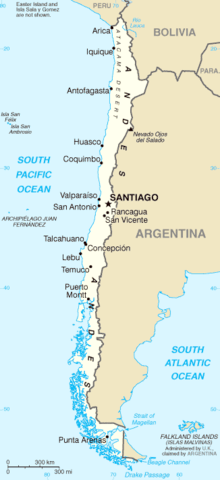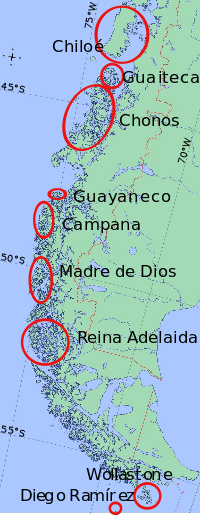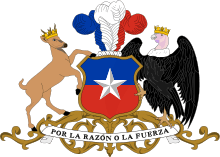Islands of Chile
The islands of Chile encompass the various islands that the government of Chile has sovereignty over. By far the majority of these are the islands in the south of the country. Chile has one of the world's longest coastlines, and one of the most dangerous for boats; it is more than 4,000 kilometres (2,500 mi) long and has at least 5,000 rocky islands.[1]
Classifications vary for isla ("island"), islote ("islet"), roquerío ("rocks"), farallón ("cliff") and archipiélago or grupo ("archipelago"). The Hydrographic and Oceanographic Service of the Chilean Navy has begun to consider island a surface greater than 100,000 m2 (1,100,000 sq ft).[2]
Island territory
The Hydrographic and Oceanographic Service of the Chilean Navy has counted 5,919 "units" of land between the 18° 15'S and 56° 32'S latitudes, with a total area of 105,561 square kilometres (40,757 sq mi), that is, 14% of Chile's territory (not including its Antarctica claims). The biggest eight islands and archipelagos (Tierra del Fuego, Chiloé, Wellington, Riesco, Hoste, Santa Inés, Navarino and Magdalena), each measuring over 2,000 km2 (770 sq mi) in area, represent 56% of the island territory of Chile. The 381 biggest islands – all those over 10 km2 (3 7⁄8 sq mi) in area – represent 97% of the island territory of Chile.


Geographic classification
The Chilean "Instituto Geográfico Militar de Chile" classifies the Chilean Islands according to their coordinate position on the coast of Chile:[3]
- Sector 1: lies between 18° 15′S and 41° 45′S. It includes 134 islands and islets, totalling 148 km2 (57 sq mi). The most known is Mocha Island.
- Sector 2: composed of islands far from the continent, only 16 islands and islets, totalling 328 km2 (127 sq mi): San Félix y San Ambrosio, Salas y Gómez, Isla de Pascua (Easter Island), Juan Fernández Islands, (Robinsón Crusoe, Santa Clara, and Alejandro Selkirk).
- Sector 3: lies between 41° 45′S and 43° 45′S. It includes 169 islands and islets totalling 9,344 km2 (3,608 sq mi), most of them near Chiloé Island.
- Sector 4: lies between 43° 44′S and 47°S, totalling 1,047 km2 (404 sq mi) and 12,344 km2 (4,766 sq mi), mainly in the Chonos Archipelago.
- Sector 5: lies between 47°S and 56° 32′S, including 4,553 islands and islets, totalling 82,945 km2 (32,025 sq mi): Isla Grande de Tierra del Fuego, Navarino, Guayaneco Archipelago and Diego Ramirez Islands.
Ocean islands
River and lake islands
- Isla del Rey
- Isla Teja
- Malvinas
Phantom islands
Elizabeth Island, Bodesta, Pactolus Bank and some reefs have been mentioned in the past as lying near Chilean territories but they are phantom islands. Gable Island is listed by National Geospatial-Intelligence Agency, Country Files (GNS)[4] as a Chilean Island, but it is actually part of Argentina.
Literature islands
Several reports, novels and tales have the islands of Chile as geographic background:
- The Narrative of the Honourable John Byron by John Byron
- The Survivors of the "Jonathan" by Jules Verne
- El último grumete de la Baquedano by Francisco Coloane
- The Golden Ocean by Patrick O'Brian
- The Unknown Shore by Patrick O'Brian
- Robinson Crusoe of Daniel Defoe
- Two Years' Vacation by Jules Verne
- The Voyage of the Beagle by Charles Darwin
- Benito Cereno by Herman Melville
- The Ice Limit by Douglas Preston and Lincoln Child, on Desolacion Island
- Hawaii by James Michener, on Desolacion Island
- The German poet Adelbert von Chamisso wrote a poem about Sala y Gomez Island based on his reflections upon visiting the island in 1816.[5]
- Ishmael, in Herman Melville's classic novel, Moby Dick, recalls a marble tablet at a whalemen's chapel in New Bedford which pays homage to a whaleman named John Talbot who lost his life whaling "near the Isle of Desolation, off Patagonia". This recollection occurs in Chapter 7, "The Chapel".
See also

- Fjords and channels of Chile
- Archipelagoes of Patagonia
- Geography of Chile
- List of Chile-related topics
References
- Russ Rowlett, Lighthouses of Southern Chile, University of North Carolina at Chapel Hill
- Ana María Errázuriz K. and Reinaldo Rioseco H. in Las islas de Chile, retrieved on 25 February 2013
- Chile y sus Islas
- The data was retrieved on 19 January 2013
- Adelbert von Chamisso (1981) Gesammelte Werke (Collected works), Band 2 (Vol. 2), Leipzig, p. 291
